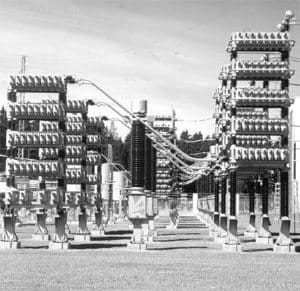
Shunt capacitor banks are used to an increasing extent at all voltage levels. There are a variety of reasons for this like the growing need for power transfer on existing lines while avoiding transfer of reactive power, better use of existing power systems, improving voltage stability, right-of-way and cost problems, voltage control and compensation of reactive loads.
Thyristor-controlled as well as breaker-switched capacitors are used. Breaker-switched capacitors are installed in distribution, HV and EHV systems. Since detailed studies generally are justified for thyristor-controlled capacitors due to the large cost savings which are possible, the general guidelines in this publication deal only with the protection of breaker-switched equipment by ZnO arresters.
Three-phase capacitor bank sizes vary from a few tenths of MVAr to several hundreds of MVAr. Both ungrounded wye and grounded wye banks are in use.
It is common practice to use ”restrikefree” breakers. However, since many banks are switched on a daily basis, the probability of obtaining high transients associated with capacitor switching increases. Furthermore, the standardized procedure to verify that the breaker is restrike-free includes only a limited number of tests.
The use of arresters not only gives protection if a restrike occurs but also decreases the probability of multiple restrikes since the trapped charge on the capacitors is reduced.
The protection afforded by different arrester protection levels and positioning (such as phase-ground, phase-phase and phaseneutral) against switching overvoltages is dealt with. Arrester energies related to different protection levels and capacitor MVAr ratings are given and the guidance is summarized in a set of diagrams.
Resonance conditions are not discussed since the duty imposed is strongly affected by system conditions and components, grounding etc. It is assumed, therefore, that harmonic and dynamic overvoltages in general are and must be limited by system design and operating procedures.










